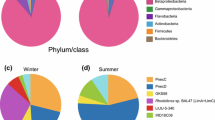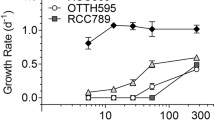In laboratory experiments, bacterioplankton were incubated under different nutrient conditions, and the percentage of bacteria exhibiting a polysaccharidic capsule (capsulated bacteria) and that of CTC (cyanotetrazolium chloride)-positive and therefore metabolically highly active bacteria were determined. In these seawater cultures amended with nutrients more than 95% of the CTC-positive cells exhibited a capsule. During two cruises, one to the North Atlantic and one to the North Sea, we investigated the distribution of capsulated bacteria throughout the water column. Capsulated bacteria were generally more abundant in eutrophic surface waters than in deeper layers or more oligotrophic regions. In the upper 100 m of the North Atlantic, about 6–14% of the total bacterioplankton community was capsulated, while in the layers below 100 m depth, 97% of the bacteria lacked a visible capsule. The percentage of capsulated bacteria correlated with bacterial abundance and production, and chlorophyll a concentration. Also, the bioavailability of DOC (dissolved organic carbon), estimated by the ratio between bacterial production and DOC concentration, significantly correlated with the percentage of capsulated bacteria. In the North Sea, the contribution of capsulated bacteria to the total number of bacteria decreased from the surface (3 m depth) to the near-bottom (25–35 m) layers from 20% to 14% capsulated bacteria. In the nearshore area of the North Sea, about 27% of the bacteria exhibited a capsule. Overall, a pronounced decrease in the contribution of capsulated bacteria to the total bacterial abundance was detectable from the eutrophic coastal environment to the open North Atlantic. Using this epifluorescence-based technique to enumerate capsulated bacterioplankton thus allowed us to routinely assess the number of capsulated bacteria even in the oceanic water column. Based on the data obtained in this study we conclude that almost all metabolically highly active bacteria exhibit a capsule, but also some of the metabolically less active cells express a polysaccharide capsule detectable with this method.
Similar content being viewed by others
Author information
Authors and Affiliations
Rights and permissions
About this article
Cite this article
Stoderegger, K., Herndl, G. Distribution of Capsulated Bacterioplankton in the North Atlantic and North Sea . Microb Ecol 44, 154–163 (2002). https://doi.org/10.1007/s00248-002-0008-5
Received:
Accepted:
Issue Date:
DOI: https://doi.org/10.1007/s00248-002-0008-5




